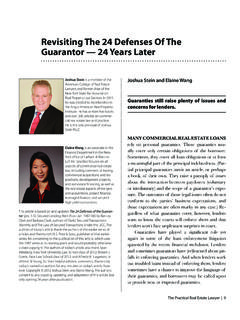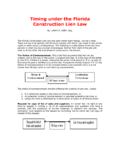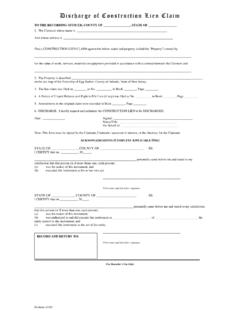Transcription of Introduction to the New York Lien Law for Counsel to ...
1 8 NYSBA Real Property Law Journal| Winter 2012| Vol. 40 | No. 1 ity of the Lien Law; (b) the limited scope of cases interpreting the Lien Law; (c) the fact-intensive nature of the scant case law that does exist; and (d) the history of surprises in this area, particularly in Article , although this article seeks to offer a general roadmap, any Owner or its Counsel must fully un-derstand the facts and think through the law that applies to them, and not rely on this summary. This article of-fers only a rudimentary Introduction to the Lien Law, and only from an Owner s point of Owner s Obligations Under the Lien LawThis article fi rst summarizes an Owner s exposure under Article 2, then turns to Article 3-A. It does so for three reasons, all discussed at greater length below:1.
2 Article 2 Lien claims have priority over Article 3-A trust claims. Article 3-A expressly blesses the use of trust assets to pay Liens,8 and imposes extra liability on an Owner that applies Article 3-A trust funds to make payments that violate Article 2 priority rules for The Article 2 priority rules restrict an Owner much more than comparable rules under Article Owner must therefore fi gure out how to contend with its Article 2 obligations before it fi gures out how to deal with Article discussion focuses primarily on Owner s Lien law problems. For a typical Project, of course, most of the money will come from a construction lender. In some ways, a lender s is-sues will overlap Owner s. The Lien In New york , Owner may also face direct claims against the Project and the real property on which it sits (together, the Site ) from unpaid Vendors, as a result of New york s fl oridly complicated and impenetra-bly opaque 4 Lien Law (the Lien Law ). The Lien Law gives Vendors two possible ways to make claims against Owner or the Site, in addition to any direct contractual rights that any particular Vendor can , Lien Law Article 2 ( Article 2 ) allows an unpaid Vendor to fi le a mechanic s lien against the Site (a Lien ) and enforce that , Lien Law Article 3-A ( Article 3-A ) creates a separate trust fund regime to protect GCs and Vendors.
3 Article 3-A makes Owner a statutory trustee over certain funds available for a Project. If Owner diverts assets from that trust, then Owner may incur liability to any Vendors that hold Liens or contracted directly with will want to minimize its Article 2 and Article 3-A exposures if a Project goes bad, whether be-cause of GC default or bankruptcy or otherwise. Owner will also want to: (1) complete the Project; (2) do so on time; and (3) do so on budget. As a practical matter, Owner will count itself lucky to achieve even the fi rst goal if GC gets into trouble. But the strategies suggested here may help Owner achieve the best possible out-come under the always, the legal rights, obli-gations, analysis, and strategy for any Project will depend on the facts and circumstances of that Project. That holds particularly true for the Lien Law. Application of the Lien Law to any set of facts usually amounts to a diffi cult exercise, given: (a) the opac-A substantial commercial con-struction project (a Project ) can go wrong in many ways.
4 One common way occurs when the general contrac-tor (the GC ) becomes insolvent or otherwise trips and falls and cannot fi nish the project. When that happens, the owner of the Project (the Own-er ) will fi nd itself in an awkward corner, potentially facing claims from parties that Owner didn t even know an Owner engages a GC under a traditional general contract, that GC agrees to build the Project for a fi xed fee1 and pay all subcontractors and material suppliers (collectively, Vendors 2). At any point during the Project, however, GC may drop the ball as suggested above, or may default in other ways. In a perfect world, , in an Owner s fantasyl-and, GC will at that point have paid all its Vendors everything due them. GC will have funded these payments from money that Owner gave GC to pay for the likely, however, GC will not be current in paying Vendors. To the contrary, GC s problems will usually also lead to delayed Vendor payments. GC will have used funds from this Project to pay other debts or clean up similar messes on previ-ous Projects.
5 Or those payments may have funded home theater systems, birthday parties, and cruises in the Caribbean and will derive cold comfort from the fact that GC remains liable to unpaid Vendors. As a practical matter, unless someone pays Vendors, they won t keep working. Although Owner could conceivably fi nish the Project with replacement Vendors, that process will cause huge disrup-tions and delays. Moreover, Owner will fi nd some Vendors so vital that Owner cannot replace to the New york Lien Law for Counsel to Owners of Troubled Construction ProjectsBy Joshua Stein and Colin Real Property Law Journal| Winter 2012| Vol. 40 | No. 1 9 facts and circumstances and how a specifi c court decides to view doctrine of substantial performance applies a little differ-ently to an installment contract, a contract structure often seen in construction. Here, Vendor accepts payments in installments based on Vendor s completion of specifi ed tasks. An installment contract might say, for example, that Vendor will receive a percentage of the contract based upon completion of each fl oor in a multifl oor building.
6 Vendor will be entitled to payment under its con-tract to the extent it has substantially performed each installment even if it has not substantially performed the entire Thus, if Vendor has substantially completed two of fi ve fl oors, it will be entitled to the con-tract price for only those two fl oors. For the other three fl oors, Vendor will be limited to quantum meruit at least until Vendor substantially com-pletes each of those three fl doctrine of substantial per-formance should not be confused with the concept of substantial completion in many construction The American Institute of Architects ( AIA ) form construction contract defi nes substantial comple-tion as the stage in the Project when Owner can occupy or utilize the[w]ork for its intended use. 24 Put another way, the AIA s version of substantial completion occurs at the point when Owner can take ben-efi cial occupancy of the construction contract will often require Vendor to demonstrate sub-stantial completion as a condition to payment, or at least as a condition to the fi nal The contract may also require Vendor to obtain a certifi cate from the architect stating that the work has been completed in accordance with the terms and condi-tions of the contract, as a condition precedent to Where a certifi cate is required, a Lien will not be enforced without such certifi cate, unless Vendor can demonstrate that it was unreasonably Vendor must fall within a certain class of persons that provide materials or services that improve property, which includes contractors, subcontractors, laborers, and material suppliers;13b.
7 Vendor must have permanently improved Owner s real property;14 andc. Owner, or its agent (who can be GC or some other Vendor) must have requested, or at least consented to, the , even if the Lien is valid, Owner faces exposure only to the extent of the unpaid balance due the Lien holder when it fi led its , Vendor must have sub-stantially performed its contract before it can collect what it is owed under its Otherwise, the Vendor can recover only in quan-tum meruit. Although the measure of damages based on substantial performance consists of the contract price less the cost of completion, the measure of damages in quantum meruit consists of the fair value of its work measured not by the contract balance, but instead by the reasonable value to Owner of Vendor s labor and A court will generally hold that Vendor has substantially per-formed if Vendor can demonstrate that it has in good faith intended to comply with the contract, and has substantially done Thus, if Vendor s work contains slight defects or deviations from the plans, it can still collect the unpaid balance of its contract minus any damage that re-sulted from defects or If, however, Vendor s work is somewhat signifi cantly incomplete or defec-tive even, , to the extent of as little as fi ve percent of the total value of the contract a court may decide that Vendor has not substantially performed.
8 21 As in so many areas of the law, and particularly the Lien Law, much depends on the particular Law s requirements for a building loan contract will, however, com-pound a lender s headaches. This article does not cover the special con-cerns of a construction Owner and Article 2 If a Vendor fi les a valid Lien un-der Article 2, Owner will need to pay that Lien or fi gure out how to get rid of it. If Owner doesn t, then eventu-ally the Lien holder can foreclose its Lien and force a sale of the Site. In the meantime, so long as a Lien remains in place, Owner may fi nd the Site unsaleable and unfi nanceable. Often, Owner cannot proceed with the Proj-ect either, because Owner s lender will refuse to fund further 2 contains two sets of rules that Owner must , Article 2 defi nes how much a Vendor can expect to successfully claim on its Lien. As against the rest of the Lien Law, these provisions are relatively , Article 2 defi nes the priorities an Owner must follow if it wants to pay multiple Lien holders.
9 These rules limit Owner s freedom to play favorites in paying Lien Owner s Liability to Mechanic s LienorsIn general, Owner faces exposure for the amount a Vendor claims in a Lien only to the extent that: (a) the Lien is valid; (b) the Lien holder s claim represents a reasonable estima-tion of the amount owed, and, (c) Owner still owes money to GC. If the Owner does not owe money to GC when a subcontractor fi les a Lien, but an open balance later arises, the Lien will attach only to the after-arising Lien Fund. 11 First, Owner is only liable to a Lien holder if the Lien is valid. To ob-tain a valid Lien, the claimant must: (a) follow numerous technicalities to properly fi le the Lien,12 and (b) meet three substantive conditions in Lien Law Section 3. Those three substan-tive conditions are:10 NYSBA Real Property Law Journal| Winter 2012| Vol.
10 40 | No. 1 Within each priority level, multi-ple Lien holders have parity, mean-ing they each take a pro rata share in proportion to their Where a single contract covers more than one building, each Vendor should have a priority claim on the part of the real property or the particular building where such Vendor s labor was per-formed or such Vendor s materials were Owner disregards these statu-tory priorities and chooses to pay certain favored Vendors fi rst, Owner should not face signifi cant penalties. Lien Law 56 states: Payments vol-untarily made upon any claim fi led as a lien shall not impair or dimin-ish the lien of any person except the person to whom the payment was made. 45 Implicitly, Lien Law 56 recognizes and permits voluntary payments of any Lien. Although pay-ments made under Lien Law 56 to certain Vendors do not diminish the Lien of other Vendors, practi-cally speaking, the payments work to reduce the overall Lien fund. First, most construction contracts will re-duce the contract price payable to GC when Owner pays Vendors and Sub-Vendors directly.









